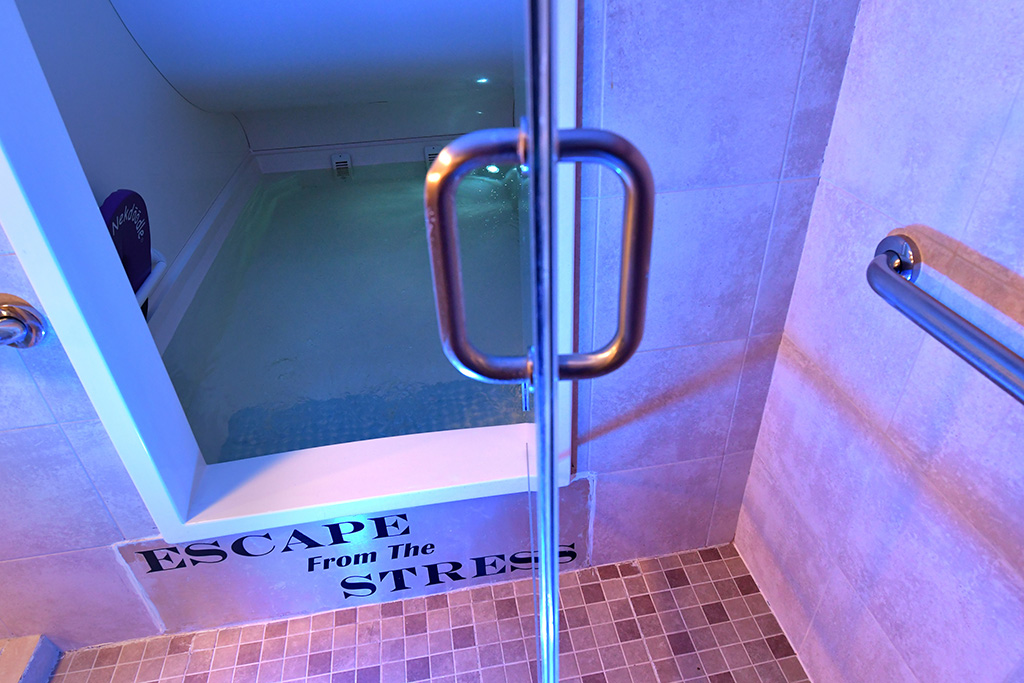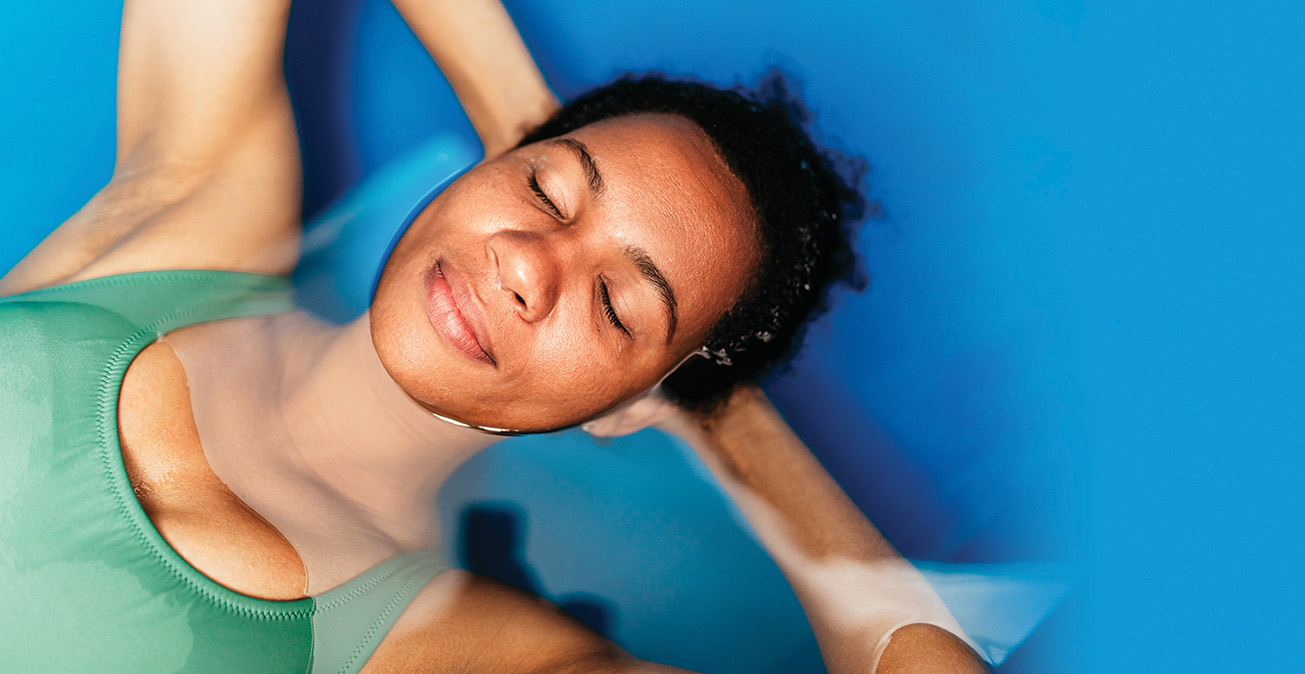Morton business offers all the benefits of a seaside soak.
Relaxation can be difficult in a world full of stress, sensory overload and sleep deprivation. Luckily, Stress Busters Massage and Float Suite in Morton offers visitors a chance to block out the world and drift in a sea of serenity.
“The float room is based on something called sensory deprivation,” said owner Mike Bell. “If you take away all your sensory inputs, your sight, sound, taste, smell, then your brain turns internally to find things that need to be fixed, adjusted or changed.”
It’s a process that happens naturally when the body goes into REM sleep, in which humans dream, process emotion, consolidate memory and improve brain function.
“They claim that an hour float is equivalent to four hours of sleep,” said Bell. “And so that was my draw to it. None of us get enough sleep.”
A roller coaster history
Float therapy was pioneered in 1954 by neuroscientist John C. Lilly, who was interested in what sensory deprivation did to the brain. Glenn Perry, a computer programmer following Lilly’s work, helped Lilly modify the initial tank design and introduced Epsom salts instead of sea water. By 1979, the first public float center opened in Beverly Hills, California.
‘They claim that an hour float is equivalent to four hours of sleep.’— Mike Bell
Floating declined drastically in the 1980s and ‘90s, but since 2010 the float industry has been rapidly growing. People who watch science fiction may have seen scary, coffin-like versions of float tanks in movies or on television, but the industry has made great strides in making the experience more approachable. Floats can happen in tanks, pods, open baths or cabin units.
Modern tanks and pods are still based on Lilly’s rectangular model. They now have more space, and some offer lighting. Bathers bend through a hatch to enter the water or pull a domed lid over themselves as the structure isn’t large enough to stand in. The float happens in an enclosed chamber. An operator knocks on the top of the tank to signal the session is complete.
While Bell was intrigued by the potential benefits of floats, he thought the knocking would be intrusive. Concerns about claustrophobia, heavy lids on pod units, and complete darkness made him wait until the industry created a more suitable option. It took Bell more than five years to settle on the cabin-style float experience offered in his Wave Float Room.

A glass shower door allows entry into cabin-style units, so nothing closes over the bather. The ceiling is more than six feet tall and slopes downward, ensuring condensation doesn’t drip into the bather’s eyes. Bell opted to get the deluxe float room, which offers underwater lighting and piped-in music for meditation.
The air and water inside the Stress Busters Float Room are kept at body temperature, giving the brain a feeling of free-floating in space. A thousand pounds of Epsom salts are dissolved in 12 inches of water, making the water dense in nutrients like magnesium. The body is so buoyant that it takes effort not to float, and there is no pressure on the hips or joints.
Ultraviolet lights and hydrogen peroxide work with the salt to keep the room clean. Ozone is pumped in to allow for comfortable breathing with minimal chemicals. Salinity and ph are checked daily. The water goes through three filtration cycles after every float session.
“It’s all computerized. I don’t have to go in there to tell you it’s time to come out. There are lights that come on. Also, there’s an intercom out to the front desk. If you have an issue, you can contact me. If I have an issue, I can contact you. And nobody has to enter.”
A diverse clientele
Bell’s float clients range from athletes looking for injury recovery to moms looking for relaxation. Regular visitors have told Bell that the float suite helps them sleep better even days after a session.
“I’ve had a couple of people get into a really deep sleep in the tank,” Bell said. “That’s what it’s all about. Checking out from the world, getting away from noise pollution, sound pollution, all those sorts of things.”
The mental benefits of floating are well documented. In a 2016 study, pro athletes said floating helped them recover psychologically from intense training. The European Journal of Integrative Medicine reported in 2014 that creative people find that floating increases imagination, focus and precision. One 60-minute float session can reduce generalized anxiety disorder symptoms like stress, depression, fatigue and sleep difficulties.
Alec Hagaman, captain of the Peoria Rivermen hockey team, said he first decided to use the float tank on the recommendation of teammates.
“A few of the guys said afterward the body is just really refreshed and they got the best sleep of their life,” he said. “It was the end of the year and my body was pretty worn down. It was so nice and peaceful to get in there and be alone with your own thoughts and just relax. Playing hockey, with all the travel, you don’t get the best sleep. It was just really refreshing.”
That doesn’t even touch on the physical benefits, such as lower cortisol levels and the removal of lactic acid. Floating can ease the symptoms of tension headaches, chronic pain and nerve issues.
Rivermen forward Tyler Barrow testified that time in the tank “greatly helps with my recovery” during a long, bruising season.
Bell relates how the anti-inflammatory benefits of the suite helped another local hockey player with a swollen face and a black eye.
“He floated and came back out, and I happened to catch him in the lobby. I had to do a double-take,” said Bell. “It pulled all the inflammation out of his face, and his eye looked 80% better. Even though the water only comes up to mid-cheek, within a week, his black eye was gone.”
Despite the benefits, Bell says float therapy isn’t for everyone. Some people find it too quiet. Anyone who gets overwhelmed can leave the suite at any time.
Bell also notes that skin irritations — cuts, sunburns, or fresh tattoos — can cause problems while floating. He suggests avoiding caffeine for a few hours and having a small snack before floating to prevent jitters. Anyone under the influence of drugs or alcohol is not allowed into the float suite, he said.
‘My body was pretty worn down. It was so nice to get in there… and just relax.’— Rivermen hockey player
Stress Busters offers the float room as a standalone service, but some people choose to add a massage. Bell emphasized that Stress Busters focuses on therapeutic massage instead of spa service.
“We’re not a fufu massage,” he said, laughing. “We’re here to relieve stress and eliminate anxiety and things we all suffer from. We work with chiropractors, trainers, athletes and soccer moms. I just like to help people feel better.”
For more information on floating or to schedule a session, go to https://floatmorton.com/.





